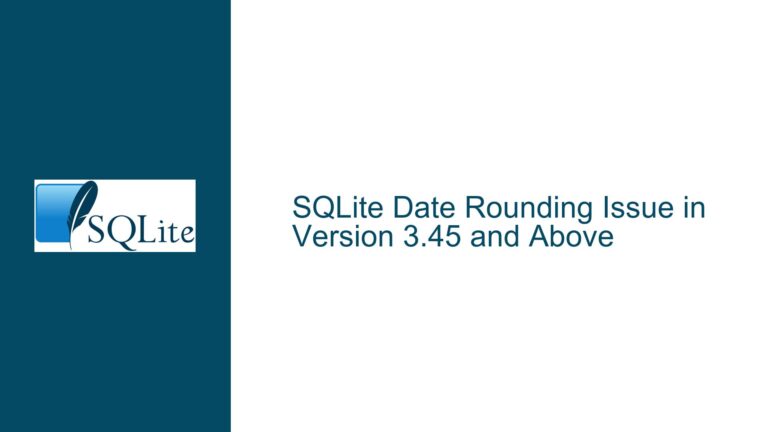Handling Virtual Columns in SQLite: Excluding Them from SELECT * Queries
The Challenge of Virtual Columns in SELECT * Queries
When working with SQLite, one of the most common tasks is querying data from tables using the SELECT * syntax. This shorthand is convenient as it retrieves all columns from a table without the need to explicitly list them. However, the introduction of virtual columns in SQLite has complicated this seemingly straightforward operation. Virtual columns, which are computed dynamically rather than stored physically in the database, are included in the result set of a SELECT * query. This behavior can be problematic in scenarios where only the non-virtual (stored) columns are desired, such as during data backups, table duplication, or when performing INSERT INTO ... SELECT operations.
The core issue arises because SELECT * does not distinguish between stored and virtual columns. This can lead to unintended consequences, such as attempting to insert computed values into a table that expects static data, or creating backup tables that include columns which cannot be reconstructed during a restore. The problem is exacerbated in tables with a large number of columns, where manually listing all non-virtual columns becomes cumbersome and error-prone.
The Role of PRAGMA table_xinfo in Identifying Virtual Columns
To address the challenge of excluding virtual columns from SELECT * queries, SQLite provides a powerful introspection tool: the PRAGMA table_xinfo command. Unlike PRAGMA table_info, which only lists stored columns, PRAGMA table_xinfo provides detailed metadata about all columns in a table, including whether they are virtual or stored. This metadata includes a hidden attribute, which is set to 2 for virtual columns and 0 for stored columns.
For example, consider a table t1 with the following schema:
CREATE TABLE t1 (
id INTEGER PRIMARY KEY NOT NULL,
a INTEGER,
b INTEGER,
c INTEGER GENERATED ALWAYS AS (a * b) VIRTUAL
);
Running PRAGMA table_xinfo('t1') yields the following result:
| cid | name | type | notnull | dflt_value | pk | hidden |
|---|---|---|---|---|---|---|
| 0 | id | INTEGER | 1 | NULL | 1 | 0 |
| 1 | a | INTEGER | 0 | NULL | 0 | 0 |
| 2 | b | INTEGER | 0 | NULL | 0 | 0 |
| 3 | c | INTEGER (VIRTUAL) | 0 | NULL | 0 | 2 |
Here, the hidden column clearly identifies c as a virtual column. This information can be leveraged to dynamically construct queries that exclude virtual columns.
Constructing Queries to Exclude Virtual Columns
The key to excluding virtual columns from SELECT * queries lies in dynamically generating a list of non-virtual columns using PRAGMA table_xinfo and then constructing a query that explicitly selects these columns. This approach can be implemented in several ways, depending on the specific use case and the tools available.
Using GROUP_CONCAT to Generate Column Lists
One effective method is to use the GROUP_CONCAT function to generate a comma-separated list of non-virtual column names. This list can then be inserted into a SELECT statement. For example:
SELECT group_concat(name, ', ')
FROM pragma_table_xinfo('t1')
WHERE hidden = 0;
This query returns a string like id, a, b, which can be used to construct a SELECT statement:
SELECT id, a, b FROM t1;
To ensure the columns are listed in the correct order, the ORDER BY cid clause should be included:
SELECT group_concat(name, ', ')
FROM (SELECT name FROM pragma_table_xinfo('t1')
WHERE hidden = 0 ORDER BY cid);
This approach guarantees that the columns are listed in the same order as they appear in the table schema.
Automating Query Construction with the eval Extension
For more advanced use cases, SQLite’s eval extension can be used to automate the construction and execution of queries. This is particularly useful when creating views or performing complex data manipulations. For example:
SELECT eval(
'CREATE VIEW vw_t1 AS SELECT ' ||
(SELECT group_concat(name, ', ')
FROM pragma_table_xinfo('t1')
WHERE hidden = 0 ORDER BY cid) ||
' FROM t1'
);
This query dynamically creates a view vw_t1 that includes only the non-virtual columns of t1. The eval function executes the generated SQL statement, making the process seamless and efficient.
Practical Applications: Backups and Table Duplication
The ability to exclude virtual columns from SELECT * queries is particularly valuable in scenarios such as data backups and table duplication. For example, consider a backup operation where data from a table t1 is copied to a backup table t1_backup:
INSERT INTO t1_backup SELECT * FROM t1;
If t1 contains virtual columns, this operation will fail because t1_backup does not have corresponding columns to store the computed values. By dynamically generating a list of non-virtual columns, the operation can be modified to:
INSERT INTO t1_backup (id, a, b)
SELECT id, a, b FROM t1;
This ensures that only the stored columns are copied, avoiding errors and preserving data integrity.
Similarly, when creating a duplicate table using CREATE TABLE ... AS SELECT, virtual columns can be excluded to ensure the new table only contains stored columns:
CREATE TABLE t1_duplicate AS
SELECT id, a, b FROM t1;
Handling Complex Schemas and Large Tables
In tables with a large number of columns or complex schemas, manually listing columns is impractical. The dynamic approach using PRAGMA table_xinfo and GROUP_CONCAT scales effortlessly, regardless of the table’s size or complexity. Additionally, this method can be encapsulated in scripts or stored procedures, making it reusable across multiple tables and databases.
Limitations and Considerations
While the techniques described above are powerful, they do have some limitations. For instance, the eval extension is not available in all SQLite environments, particularly in embedded or restricted systems. In such cases, the dynamic SQL must be constructed and executed by the application layer.
Furthermore, the use of PRAGMA table_xinfo requires that the table schema is known and accessible at query time. In scenarios where the schema is dynamic or unknown, additional steps may be needed to retrieve and process the schema information.
Conclusion
The inclusion of virtual columns in SELECT * queries presents a significant challenge in SQLite, particularly in scenarios where only stored columns are desired. By leveraging PRAGMA table_xinfo and dynamic SQL construction, it is possible to exclude virtual columns and achieve the desired results. This approach not only simplifies query construction but also enhances data integrity and operational efficiency. Whether for data backups, table duplication, or general querying, these techniques provide a robust solution to a common problem in SQLite database management.






